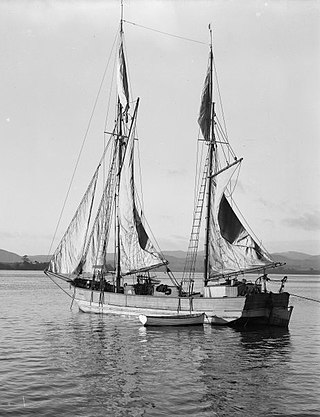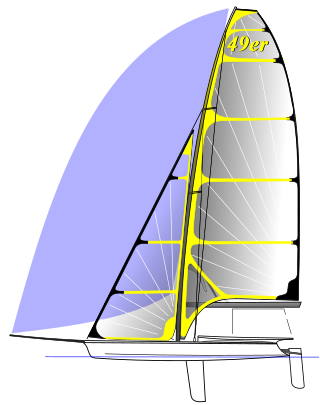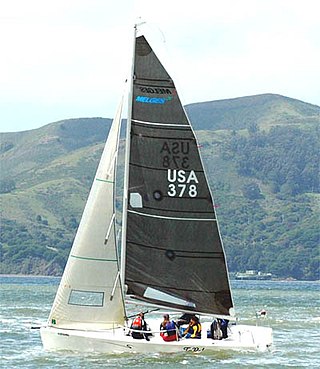
Dinghy sailing is the activity of sailing small boats by using five essential controls:

A scow is a smaller type of barge. Some scows are rigged as sailing scows. In the 19th and early 20th centuries, scows carried cargo in coastal waters and inland waterways, having an advantage for navigating shallow water or small harbours. Scows were in common use in the American Great Lakes and other parts of the U.S., Canada, southern England, and New Zealand. In modern times their main purpose is for recreation and racing.

Dinghy racing is a competitive sport using dinghies, which are small boats which may be rowboats, have an outboard motor, or be sailing dinghies. Dinghy racing has affected aspects of the modern sailing dinghy, including hull design, sail materials and sailplan, and techniques such as planing and trapezing.

The 49er and 49er FX is a two-handed skiff-type high-performance sailing dinghy. The two crew work on different roles with the helm making many tactical decisions, as well as steering, and the crew doing most of the sail control. Both of the crew are equipped with their own trapeze and sailing is done while cantilevered over the water to the fullest extent to balance against the sails.
A skiff is any of a variety of essentially unrelated styles of small boats. Traditionally, these are coastal craft or river craft used for leisure, as a utility craft, and for fishing, and have a one-person or small crew. Sailing skiffs have developed into high performance competitive classes. Many of today's skiff classes are based in Australia and New Zealand in the form of 12 ft (3.66 m), 13 ft (3.96 m), 16 ft (4.88 m) and 18 ft (5.49 m) skiffs. The 29er, 49er, SKUD and Musto Skiff are all considered to have developed from the skiff concept, all of which are sailed internationally.
The International Offshore Rule (IOR) was a measurement rule for racing sailboats. The IOR evolved from the Cruising Club of America (CCA) rule for racer/cruisers and the Royal Ocean Racing Club (RORC) rule.

The 18 ft Skiff is considered the fastest class of sailing skiffs. The class has a long history beginning with races on Sydney Harbour, Australia in 1892 and later in New Zealand. The boat has changed significantly since the early days, bringing in new technology as it became available. Because of the need of strength, agility and skill, the class is considered to be the top level of small boat sailing. Worldwide this boat is called the "18 Foot Skiff". It is the fastest conventional non-foiling monohull on the yardstick rating, with a score of 675, coming only third after the Tornado and Inter 20.

The International 14 is a British racing sailboat, crewed by two sailors. The class was established in 1928.

The Moth is a small development class of sailing dinghy. Originally a small, fast home-built sailing boat designed to plane, since 2000 it has become an expensive and largely commercially produced boat designed to hydroplane on foils though many are still built at home, typically at much lower cost.

The 12 ft Skiff is a development dinghy class dating back to the early 20th century. It is sailed in Australia and New Zealand. It is 12 ft (3.7 m) in length, hence the name, and is a two-man boat. Both the crew and the helm are able to use the trapeze at the same time. It has an asymmetrical spinnaker and a jib, in addition to the mainsail.

The Thames A Class Rater is both a historic and modern specialist sailing craft designed for the particular conditions at Thames Sailing Club, on the River Thames at Surbiton in England. The class is a development of the Half Rater, which was designed by Linton Hope and Alfred Burgoyne in 1907. The rules refer to the craft as a yacht.

The Cherub is a 12 feet long, high performance, two-person, planing dinghy first designed in 1951 in New Zealand by John Spencer. The class is a development class, allowing for significant variation in design between different boats within the rule framework. The minimum hull weight was originally 110 lbs.

A sailing yacht, is a leisure craft that uses sails as its primary means of propulsion. A yacht may be a sail or power vessel used for pleasure, cruising, or racing. There is no standard definition, so the term applies here to sailing vessels that have a cabin with amenities that accommodate overnight use. To be termed a "yacht", as opposed to a "boat", such a vessel is likely to be at least 33 feet (10 m) in length and have been judged to have good aesthetic qualities. Sailboats that do not accommodate overnight use or are smaller than 30 feet (9.1 m) are not universally called yachts. Sailing yachts in excess of 130 feet (40 m) are generally considered to be superyachts.

The term sportsboat first appeared in the late 1980s and early 1990s to describe trailer sailers that were optimised for high performance at the expense of accommodation and ballast. The very definition of the term "sportsboat" is evolving.

The Butterfly is a one-design sailing dinghy, originally designed for a crew of two, but now most commonly raced single-handed. It was designed in 1961 in Libertyville, Illinois by John Barnett. The 12-foot (3.7 m) hull is a scow design. The craft has a stayed 18-foot (5.5 m) mast set as a Marconi rig with a single mainsail with a 75-square-foot (7.0 m2) surface area. The cockpit is 15 ½" deep, exceptionally deep for this size of sailboat, and can accommodate an adult up to 6 feet in height.
The JJ Giltinan International Trophy is considered the world's premier 18-foot skiff open championship, the eponymous brainchild of noted Australian sports entrepreneur J. J. Giltinan.

Two foot skiffs also known as ‘Balmain Bugs’ were model racing skiffs typically raced on Sydney Harbour between the 1890s and 1950s. The model skiffs were crafted by shipwrights in their spare time. In the sports hey days the 1940s and 1950s there were up to 10 clubs at Abbotsford, Drummoyne, Balmain, North Sydney and Double Bay. They raced with large rigs including four foot bowsprits to hold the oversize jib and spinnaker, with masts which were up to 10 feet (3 m) high, the keel was designed as a dagger blade fin with a lead bulb weighing up to 24 pounds (11 kg).

Sydney Flying Squadron Yacht club was founded in 1891 by Mark Foy in the birthplace of the famous Sydney Harbour sailing skiff classes. It was founded to allow people to enjoy skiff sailing regardless of financial background. The Sydney Flying Squadron, affectionately called The Squaddy by its members and locals, is Australia's oldest open boat sailing club on the shores of Sydney Harbour.
The Skate is a high performance two-person racing dinghy unique to Australia. Designed as a monohull sailboat it's fourteen feet long (4.27m) with a 7.2m mast, 1.8m bow pole and masthead asymmetrical spinnaker. It is an Australian national class.
Lake Macquarie Yacht Club (LMYC) is a yacht club located on Ada Street, Belmont, New South Wales, Australia.















